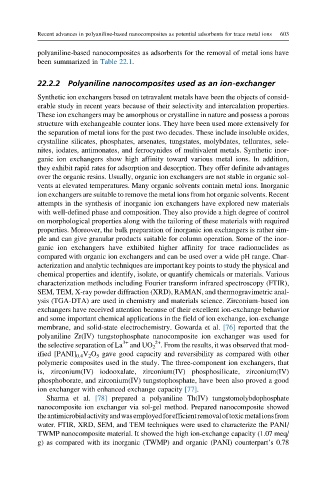Page 653 - Polymer-based Nanocomposites for Energy and Environmental Applications
P. 653
Recent advances in polyaniline-based nanocomposites as potential adsorbents for trace metal ions 603
polyaniline-based nanocomposites as adsorbents for the removal of metal ions have
been summarized in Table 22.1.
22.2.2 Polyaniline nanocomposites used as an ion-exchanger
Synthetic ion exchangers based on tetravalent metals have been the objects of consid-
erable study in recent years because of their selectivity and intercalation properties.
These ion exchangers may be amorphous or crystalline in nature and possess a porous
structure with exchangeable counter ions. They have been used more extensively for
the separation of metal ions for the past two decades. These include insoluble oxides,
crystalline silicates, phosphates, arsenates, tungstates, molybdates, tellurates, sele-
nites, iodates, antimonates, and ferrocynides of multivalent metals. Synthetic inor-
ganic ion exchangers show high affinity toward various metal ions. In addition,
they exhibit rapid rates for adsorption and desorption. They offer definite advantages
over the organic resins. Usually, organic ion exchangers are not stable in organic sol-
vents at elevated temperatures. Many organic solvents contain metal ions. Inorganic
ion exchangers are suitable to remove the metal ions from hot organic solvents. Recent
attempts in the synthesis of inorganic ion exchangers have explored new materials
with well-defined phase and composition. They also provide a high degree of control
on morphological properties along with the tailoring of these materials with required
properties. Moreover, the bulk preparation of inorganic ion exchangers is rather sim-
ple and can give granular products suitable for column operation. Some of the inor-
ganic ion exchangers have exhibited higher affinity for trace radionuclides as
compared with organic ion exchangers and can be used over a wide pH range. Char-
acterization and analytic techniques are important key points to study the physical and
chemical properties and identify, isolate, or quantify chemicals or materials. Various
characterization methods including Fourier transform infrared spectroscopy (FTIR),
SEM, TEM, X-ray powder diffraction (XRD), RAMAN, and thermogravimetric anal-
ysis (TGA-DTA) are used in chemistry and materials science. Zirconium-based ion
exchangers have received attention because of their excellent ion-exchange behavior
and some important chemical applications in the field of ion exchange, ion-exchange
membrane, and solid-state electrochemistry. Gowarda et al. [76] reported that the
polyaniline Zr(IV) tungstophosphate nanocomposite ion exchanger was used for
2+
3+
the selective separation of La and UO 2 . From the results, it was observed that mod-
ified [PANI] 0.4 V 2 O 5 gave good capacity and reversibility as compared with other
polymeric composites used in the study. The three-component ion exchangers, that
is, zirconium(IV) iodooxalate, zirconium(IV) phosphosilicate, zirconium(IV)
phosphoborate, and zirconium(IV) tungstophosphate, have been also proved a good
ion exchanger with enhanced exchange capacity [77].
Sharma et al. [78] prepared a polyaniline Th(IV) tungstomolybdophosphate
nanocomposite ion exchanger via sol-gel method. Prepared nanocomposite showed
theantimicrobialactivityandwasemployedforefficientremovaloftoxicmetalionsfrom
water. FTIR, XRD, SEM, and TEM techniques were used to characterize the PANI/
TWMP nanocomposite material. It showed the high ion-exchange capacity (1.07 meq/
g) as compared with its inorganic (TWMP) and organic (PANI) counterpart’s 0.78

